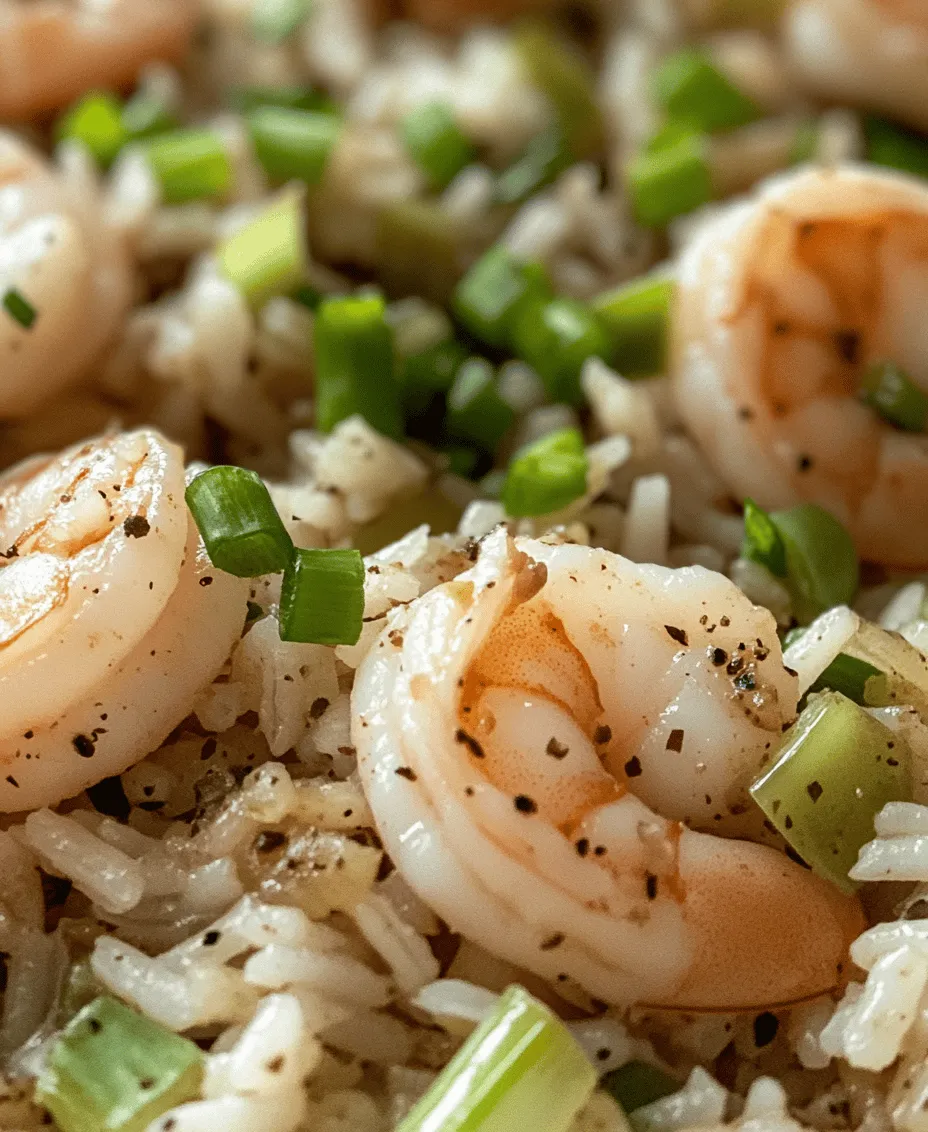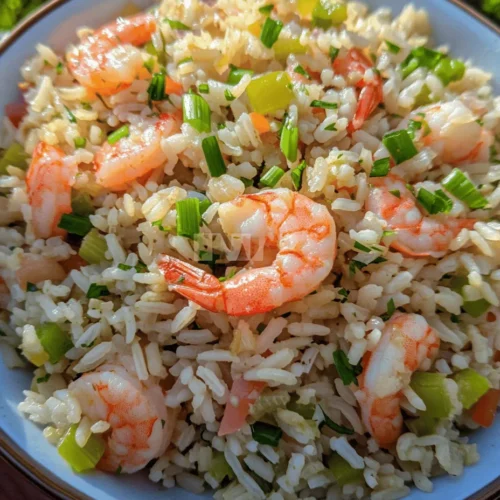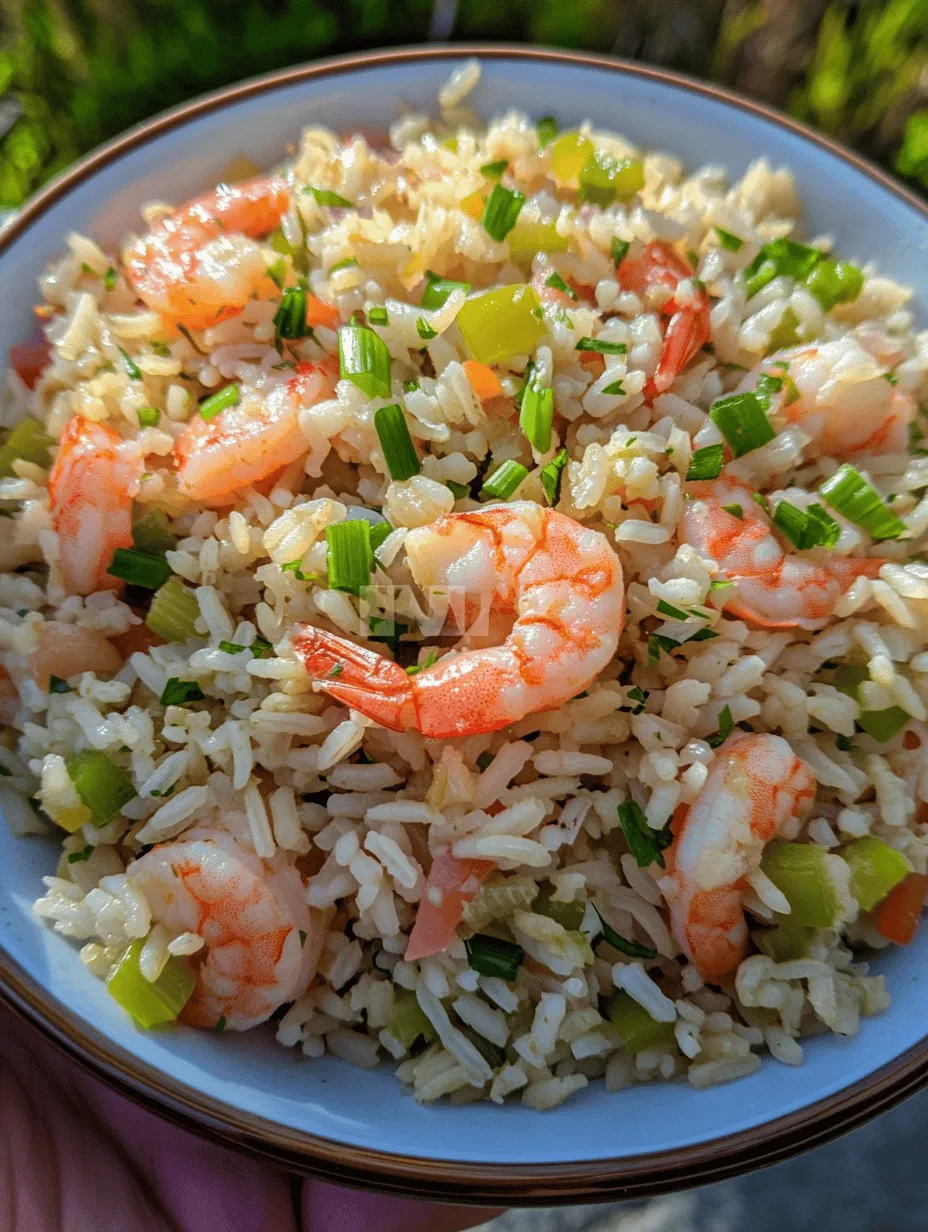Introduction
Discover the rich and flavorful world of Southern cuisine with our delightful Shrimp Dirty Rice recipe. This dish perfectly marries the succulent taste of shrimp with the hearty texture of seasoned rice, making it a staple for gatherings and family meals alike. The vibrant ingredients blend seamlessly to create a dish that is not only satisfying but also impressively rich in flavor. Whether you’re looking to spice up your dinner menu or serve a crowd-pleasing dish, Shrimp Dirty Rice is sure to become a favorite in your culinary repertoire.
The beauty of this dish lies in its versatility. You can enjoy it as a standalone meal or as a side, complementing various main dishes. The bold flavors and satisfying textures make it a delightful option for any occasion, from casual weeknight dinners to lively celebrations. With straightforward preparation steps and common ingredients, this Shrimp Dirty Rice recipe invites both novice and experienced cooks to explore the depths of Southern cooking.
Origins of Dirty Rice
Exploring the Cultural Significance of Dirty Rice
Dirty Rice, a dish deeply rooted in the culinary traditions of Louisiana, embodies the vibrant and diverse influences of Cajun and Creole cultures. Its origins can be traced back to the rural communities of Louisiana, where resourcefulness and creativity in the kitchen were essential for survival. Traditionally, Dirty Rice was made using leftover meats and seasonings, allowing families to create a hearty meal from what might otherwise be discarded.
Understanding the Dish’s Roots in Cajun and Creole Cooking
Cajun cooking, with its rustic and hearty approach, emphasizes the use of fresh, local ingredients, while Creole cuisine introduces a more refined mix of flavors and techniques. Dirty Rice showcases this fusion by incorporating elements from both culinary styles. The dish typically includes ground meats, vegetables, and spices, all cooked together to create a savory “dirty” appearance. The rice absorbs the flavors from the meats and seasonings, resulting in a rich and satisfying meal.
Over the years, Dirty Rice has evolved from its humble beginnings into a beloved dish that represents the heart of Southern hospitality. It is often served at family gatherings, celebrations, and festive occasions, making it a symbol of togetherness and community. As it gained popularity beyond Louisiana, various adaptations emerged, allowing cooks from different regions to put their unique spin on this classic dish.
How Dirty Rice Has Evolved Over the Years
The evolution of Dirty Rice reflects the changing tastes and preferences of those who prepare it. While traditional recipes often relied on whatever meats were available, modern interpretations frequently feature shrimp, chicken, or even vegetarian options. This adaptability has allowed Dirty Rice to remain relevant, appealing to a diverse range of palates while still honoring its rich history.
In recent years, the rise of food culture and the accessibility of global ingredients have led to new adaptations of Dirty Rice, integrating flavors from other cuisines. Chefs and home cooks alike experiment with unique spices, vegetables, and protein combinations, giving the dish a contemporary twist while preserving its essence. As a result, Shrimp Dirty Rice has become not just a dish of the South but a beloved comfort food enjoyed by many around the world.
Key Ingredients Overview
Highlighting the Main Components of the Recipe
To create the perfect Shrimp Dirty Rice, it’s essential to understand the key ingredients that contribute to its flavor and texture. Each component plays a vital role in achieving a balanced and delicious dish.
The Role of Shrimp: Nutritional Benefits and Flavor
Shrimp is the star of this dish, providing not only a delightful seafood flavor but also an array of nutritional benefits. Rich in protein, low in calories, and packed with essential nutrients like omega-3 fatty acids, vitamin D, and selenium, shrimp is a healthy addition to any meal. When cooked properly, shrimp offers a tender texture that complements the heartiness of the rice. Its natural sweetness pairs beautifully with the savory spices and aromatics, enhancing the overall flavor profile of the dish.
Long-Grain Rice: Choosing the Right Type for Optimal Texture
The choice of rice is crucial for creating the ideal texture in Shrimp Dirty Rice. Long-grain rice, such as basmati or jasmine, is preferred for its ability to remain fluffy and separate during cooking. These rice varieties absorb flavors well while maintaining their structure, preventing the dish from becoming mushy. For best results, it’s important to rinse the rice before cooking to remove excess starch, which can lead to clumping.
Ground Pork vs. Sausage: Which to Choose and Why
In traditional Dirty Rice recipes, ground pork is often used for its rich flavor and fat content. However, many cooks opt for sausage, which adds an extra layer of seasoning and complexity to the dish. Whether you choose spicy Italian sausage, andouille sausage, or a milder variety, the key is to select a product that complements the overall flavor. If you prefer a leaner option, ground turkey or chicken can be substituted while still achieving a satisfying result.
The Importance of Fresh Vegetables in Flavor Development
Fresh vegetables are essential for building the foundation of flavor in Shrimp Dirty Rice. Commonly used vegetables include onions, bell peppers, and celery, known as the “Holy Trinity” of Cajun cooking. These aromatics provide a balanced sweetness and depth of flavor. Additionally, garlic and green onions can be added for an extra kick. Incorporating fresh produce not only enhances the taste but also contributes essential nutrients, making this dish a wholesome choice.
The Flavor Profile of Cajun Seasoning
An In-Depth Look at Cajun Seasoning
Cajun seasoning is the heart and soul of Dirty Rice, infusing the dish with its signature bold and zesty flavor. A well-balanced blend of spices, Cajun seasoning typically includes paprika, onion powder, garlic powder, cayenne pepper, thyme, and oregano. Each ingredient plays a crucial role in creating the dish’s distinct taste profile.
Common Ingredients Found in Cajun Spice Blends
While the proportions may vary, many traditional Cajun spice blends share common ingredients, which enhance the overall flavor of the dish. Paprika lends a mild sweetness and vibrant color, while garlic and onion powders add depth and aroma. Cayenne pepper introduces heat, which can be adjusted based on personal preference. Dried herbs like thyme and oregano contribute earthiness, rounding out the flavor spectrum.
Balancing Heat: Understanding Spices Like Black Pepper and Cayenne
One of the defining characteristics of Cajun cuisine is its ability to balance heat and flavor. Black pepper and cayenne are two spices that provide warmth without overwhelming the palate. Understanding the level of heat you desire is crucial in achieving the perfect Cajun seasoning blend. If you’re sensitive to spice, start with smaller amounts and gradually increase to suit your taste.
How Seasoning Enhances the Overall Dish
The art of seasoning is essential to the success of Shrimp Dirty Rice. The right blend of spices elevates the dish, transforming simple ingredients into a vibrant and flavorful meal. As the seasoning melds with the shrimp, rice, and vegetables during cooking, it creates a harmonious balance that defines the essence of Dirty Rice.
Step-by-Step Preparation
A Detailed Guide to Cooking Shrimp Dirty Rice
Now that we’ve explored the key ingredients and flavor profiles of Shrimp Dirty Rice, let’s dive into the step-by-step preparation. This detailed guide will help you navigate the cooking process with ease, ensuring you achieve delectable results.
Preparing Your Ingredients: Mise en Place for Success
Before you begin cooking, it’s important to prepare your ingredients. This practice, known as “mise en place,” involves gathering and organizing all your components before starting the cooking process. Chop your vegetables, measure out the rice, and have your shrimp and meat ready to go. This will streamline your cooking experience and prevent any last-minute scrambling.
Sautéing the Aromatics: The Foundation of Flavor
Begin by heating a large skillet or Dutch oven over medium heat. Add a tablespoon of oil, and once hot, toss in your chopped onions, bell peppers, and celery. Sauté the vegetables until they become tender and fragrant, about 5-7 minutes. This step builds the foundational flavors of the dish, so take your time to ensure they are well-cooked and aromatic. Adding minced garlic towards the end of this process will enhance the flavor even further.
Cooking the Meat: Tips for Achieving the Perfect Brown
Once your aromatics are ready, it’s time to introduce your chosen meat. Whether you’re using ground pork, sausage, or a combination, add it to the skillet and break it up with a spatula. Cook until the meat is browned and cooked through, ensuring it is evenly distributed with the vegetables. This step is crucial for developing the rich, savory flavor that Dirty Rice is known for. Don’t rush this process—allow the meat to brown properly for the best results.
The Importance of Layering in Flavors: Adding Seasonings
As the meat cooks, it’s time to incorporate your Cajun seasoning. Sprinkle the spices over the mixture, stirring to combine evenly. This layering of flavors is key to achieving depth in your dish. Allow the seasoning to cook for a minute or two, releasing its aroma and intensifying the flavor before adding the rinsed rice and broth. This careful layering creates a symphony of taste that defines the essence of Shrimp Dirty Rice.
With these initial steps underway, you’re well on your way to crafting a delicious Shrimp Dirty Rice that will impress your family and friends. Stay tuned for the next part, where we will delve into the finishing touches and cooking techniques that will elevate your dish even further.

Cooking the Rice: Techniques for Perfectly Fluffy Rice
Achieving perfectly fluffy rice is essential for the success of your Shrimp Dirty Rice. The texture of the rice complements the seasoned shrimp and enhances the overall dish. Here are some techniques to ensure your rice comes out just right:
1. Choosing the Right Rice: Long-grain rice, such as jasmine or basmati, is the best choice for Shrimp Dirty Rice. These varieties remain separate and fluffy, avoiding the clumpiness that short-grain rice can sometimes exhibit.
2. Rinsing: Always rinse the rice under cold water before cooking. This step removes excess starch, which can lead to gummy rice. Rinse until the water runs clear for optimal results.
3. Water Ratio: The standard water-to-rice ratio is typically 2:1, but this can vary slightly based on the type of rice. Check the packaging for specific instructions. For extra flavor, consider using chicken broth or seafood stock instead of water.
4. Cooking Method: You can either use a rice cooker or a stovetop method. If using the stovetop, bring the water to a boil, add the rinsed rice, reduce the heat to low, cover, and simmer. Avoid lifting the lid during cooking, as this traps steam.
5. Resting: After cooking, let the rice sit covered for about 10 minutes. This resting period allows the rice to finish cooking through residual steam, resulting in a fluffy texture.
Folding in the Shrimp: Ensuring Even Cooking
Once your rice is fluffy and ready, it’s time to fold in the shrimp for your Shrimp Dirty Rice. Here’s how to ensure your shrimp is cooked evenly and integrates well with the rice:
1. Cooking the Shrimp: If you haven’t already cooked your shrimp, sauté them in a pan with a bit of oil over medium heat. Cook for 3-4 minutes until they turn pink and opaque. Remove them from the pan and set aside.
2. Combining: In the same pan, with the remaining seasonings, gently fold the cooked shrimp into the rice. Use a large spatula or wooden spoon to carefully mix, ensuring the shrimp is evenly distributed throughout the rice without breaking them apart.
3. Final Touches: Stir in any additional seasonings, such as green onions or parsley, and let the mixture heat through for another minute or two. This final step helps to marry the flavors, making every bite a delicious blend of shrimp and seasoned rice.
Serving Suggestions
To enhance your Shrimp Dirty Rice experience, consider these complementary dishes and pairings:
Side Dishes That Enhance the Meal
1. Collard Greens: A classic Southern side dish that adds a vibrant color and earthy flavor to your meal. Their slight bitterness contrasts beautifully with the richness of the shrimp and rice.
2. Cornbread: The slight sweetness of cornbread pairs perfectly with the savory shrimp dish. Serve it warm with a drizzle of honey or a pat of butter.
3. Fried Green Tomatoes: These crispy delights add texture and a tangy flavor that balance out the richness of the Dirty Rice.
Beverage Pairings: What to Drink with Shrimp Dirty Rice
1. White Wine: A crisp Sauvignon Blanc or a light Pinot Grigio complements the seafood beautifully without overpowering the dish.
2. Craft Beer: A fruity pale ale or a light lager pairs well with the spices in the shrimp, enhancing the overall dining experience.
3. Iced Tea: A classic Southern beverage, sweetened or unsweetened, offers a refreshing contrast to the flavors of the dish.
Creative Ways to Present Your Dish for Maximum Appeal
1. Garnish: Sprinkle chopped fresh herbs, such as parsley or cilantro, on top of the dish for a burst of color and freshness.
2. Serving Bowls: Use colorful serving bowls to present the rice and shrimp. A rustic, wooden platter can create a warm, inviting display.
3. Lemon Wedges: Serve with lemon wedges on the side for guests to squeeze over their plates, adding a little brightness and acidity to balance the flavors.
Nutritional Information
Understanding the health benefits of your Shrimp Dirty Rice can help you appreciate this dish even more.
Breakdown of Calories and Macronutrients
A typical serving of Shrimp Dirty Rice contains approximately 450-500 calories, depending on the portion size and ingredients used. Here’s a rough breakdown:
– Protein: Shrimp is a lean protein source, providing about 20-25 grams per serving, essential for muscle building and repair.
– Carbohydrates: The rice contributes around 60 grams of carbohydrates, offering energy for your daily activities.
– Fats: The dish contains about 10-15 grams of fat, primarily from cooking oils and any added ingredients.
The Role of Ingredients in a Balanced Diet
Shrimp is low in calories and high in protein, making it an excellent choice for maintaining a healthy diet. Additionally, the spices and vegetables used in the recipe add essential vitamins and minerals. Brown rice can be used as an alternative for added fiber and nutrients.
Potential Modifications for Dietary Requirements
If you or your guests have specific dietary restrictions, here are some modifications:
– Gluten-Free: Ensure all seasonings and stocks used are certified gluten-free.
– Lower Sodium: Opt for low-sodium broth and limit added salt.
– Allergy Considerations: If shrimp allergies are a concern, consider substituting with diced chicken or tofu for a similar texture.
Variations on the Classic Recipe
Exploring creative twists on Shrimp Dirty Rice can keep your meals exciting and cater to different dietary preferences.
Vegetarian or Vegan Alternatives
For a vegetarian or vegan version of Shrimp Dirty Rice, replace shrimp with sautéed mushrooms or jackfruit, which can mimic the texture of seafood. Use vegetable broth instead of chicken broth, and add a variety of vegetables like bell peppers, zucchini, or peas for added flavor and nutrition.
Using Different Proteins: Chicken, Beef, or Tofu
If you prefer different proteins, feel free to experiment:
– Chicken: Diced chicken thighs or breasts can be sautéed and mixed into the rice, providing a heartier option.
– Beef: Ground beef can be seasoned similarly and added for a comforting twist.
– Tofu: Firm tofu, when marinated and sautéed, can provide a satisfying plant-based protein option.
Flavor Enhancements: Adding Fruits or Nuts
Consider adding fruits or nuts to elevate the dish. For example:
– Dried Fruits: Raisins or cranberries can introduce a sweet contrast to the savory flavors.
– Nuts: Chopped pecans or almonds can add a delightful crunch and nutty flavor.
Tips for Perfecting Your Shrimp Dirty Rice
To help you achieve the best results with your Shrimp Dirty Rice, here are some expert tips:
Avoiding Common Mistakes in Cooking Rice
– Don’t Overcrowd the Pot: Cooking too much rice at once can lead to uneven cooking. Stick to the recommended serving sizes.
– Avoid Peeking: Lifting the lid during cooking allows steam to escape, which can result in undercooked rice.
Adjusting Spices to Suit Your Taste Preferences
The beauty of Shrimp Dirty Rice lies in its versatility. Feel free to adjust the spices based on your preference. If you prefer a milder dish, reduce the cayenne pepper or exclude it altogether. Alternatively, if you love heat, add a dash of hot sauce or extra cayenne.
Storing Leftovers and Reheating Properly
If you have leftover Shrimp Dirty Rice, store it in an airtight container in the refrigerator for up to three days. To reheat, add a splash of broth or water to prevent the rice from drying out and microwave it for a quick meal. For best results, reheat it on the stovetop over medium heat, stirring occasionally.
Conclusion
The Shrimp Dirty Rice recipe is not just a meal; it is a celebration of flavors that brings together the community and family. With its rich history and diverse variations, this dish can be tailored to fit any occasion, making it a versatile addition to your cooking repertoire. Embrace the warmth of Southern cooking and savor the delightful experience of preparing and sharing Shrimp Dirty Rice with your loved ones.
Whether you stick to the classic recipe or explore creative variations, Shrimp Dirty Rice is sure to become a favorite in your household. Enjoy the process of cooking and the joy of sharing this delicious dish with family and friends. Your journey in the kitchen will not only satisfy your taste buds but also create lasting memories around the dining table.


